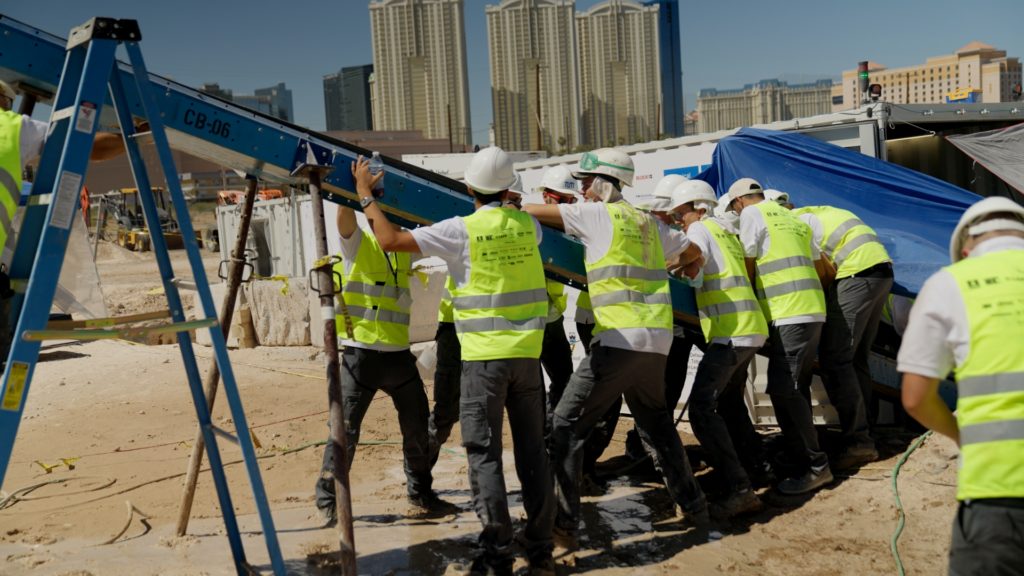
When Elon Musk tweets about traffic inefficiencies, people listen—including a team of 60 highly motivated students from the Technical University of Munich (TUM). Their team, called TUM Boring, are creating the world’s fastest tunnel boring machine, a step toward disrupting the future of transportation.
Founded in 2016 by Elon Musk, The Boring Company’s mission is to solve today’s most pressing transportation problems by creating “boring tunnels” using advanced drilling techniques. This has inspired designers and engineers around the world, throwing down a gauntlet: the Not-a-Boring Competition, which challenges teams to come up with innovative tunneling solutions.
TUM Boring from Munich became the team to watch. Building momentum, the TUM Boring team were selected as one of 12 finalists from more than 400 teams worldwide to compete in the Not-a-Boring Competition. This put them in the top 3% of competitors worldwide, tasked with boring a tunnel as quickly and accurately as possible. In September, the TUM Boring team’s technology—focused on speed, automation design, and sustainability—blew their competitors out of the water, winning the competition in one fell swoop.
The TUM Boring team is anything but boring—collectively and as individuals. Haokun Zheng, one of five leads largely responsible for project operations, is a 20-year-old student beginning the third and final year of his bachelor’s degree in computer science, specializing in informatics. Here, he shares the team’s accomplishments, their experience engineering the boring machine, and what lies ahead.

How did you first get involved in the Not-a-Boring competition?
Our university has a rich history with Elon Musk’s competitions. We were able to win four out of four SpaceX Hyperloop Pod Competitions beforehand. With those previous successes, it was relatively easy to find enough motivated people once the new Not-a-Boring Competition was announced. We started as a small group of roughly 10 students in July 2020. After determining that we wanted to participate in this competition, we expanded our team through a recruiting phase to over 60 members.
That puts you in the top echelon of competitors worldwide, which is very impressive. What did it mean to you and your team to win the competition?
Having worked on the machine and this tunnel boring project for around 60–80 hours a week for over a year as a team of 60 students, everyone was overjoyed when learning about the win. We were relieved to know that all the hard work was worth it. Throughout the last year, we have been repeatedly told by industry experts that the timeline we were aiming for was borderline impossible to adhere to and it was not straightforward to secure funding and corporate sponsors during a global pandemic.
Having overcome these obstacles and maintained our focus on winning has created a sense of profound accomplishment. Seeing our machine working and in action also filled us with a lot of pride. After having spent the last year designing, manufacturing, and assembling our 40-foot long and 22-ton heavy machine, we were very excited when it was lifted off the truck and lowered into its final position for the all-deciding tunneling run. To be able to build such a massive and complex machine as a team of students is not an opportunity that one encounters every day. We all cherish this unique opportunity and the time we have spent together as a team working on this project.
What an incredible accomplishment! What inspired you and the team to choose Fusion 360 for your tunneling solution?
Fusion 360 is easy to access for students. And because it is a cloud-based solution, it is very practical for remote collaboration. Fusion 360 is easy to get started with and functionality like taking measurements and taking notes on the site really help. Although we outsourced the production of most CNC parts and therefore only used CAM in a few cases, having CAD and FEM integrated in one program allowed for quick simulations and improved efficiency of the design workflow.
You mention remote collaboration—how did the pandemic disrupt your process?
Given contact-restrictions that were in place, we were not able to meet in larger groups in-person. Being able to collaborate with each other remotely thanks to the cloud integration really enabled us to work on our machine without having to sit out the pandemic. [This] is probably one of the main reasons why we were able to finish the machine in this very tight time schedule for the Not-a-Boring Competition.
This project requires convergence of roles and skills. How do you think this prepares you and your teammates for your future careers?
A university lecture can provide a student with theoretical knowledge but critically falls short on being able to simulate and convey what a practical application of the theoretical knowledge looks like. Having the possibility to work with an interdisciplinary team of motivated students to build an actual physical machine teaches you all the collaboration and communication soft skills that a lecture simply cannot. Having worked together efficiently as a team under high stress and time pressure for an entire year equips us with incredibly valuable team and leadership experience. This serves as a great compliment to our academic education and is highly desired by employers for an effective and efficient deployment as an employee.
